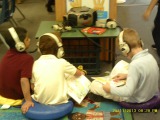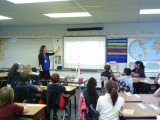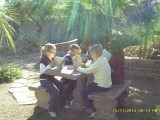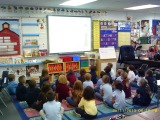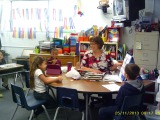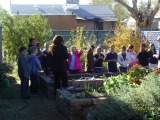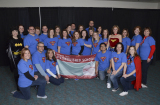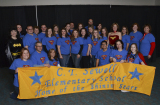-
Category 2
Selected in 2013
-
Grades: pre k - 5
School Setting: urban
Town Population: 265
Student Enrollment: 784
Student Demographics:
Black/African American: 11.7%
Teacher/Student Ratio: 1:25
White/Caucasian: 50.4%
Hispanic: 24.6%
Hawaiian/Pacific Islander: 1%
Asian: 3%
Native American: 1%
Other: 8.3%
% Reduced Lunch: 73.4%
% ELL Learners: 7.2%
Founded: 1959 -
PRINCIPAL:
Carrie Buck -
CONTACT:
700 E Lake Mead Dr.
Henderson, NV 89015
702-799-8940
cabuck@interact.ccsd.net
C.T. Sewell Elementary
Henderson, NV
Based on formative assessment results, teachers put interventions in place and progress monitor students, as they assess and graph progress on students at least once a week. Teachers work with parents to glean information about the student and communicate interventions that can be supported at home.
- Describe specific programs in place to ensure that families are involved in the success of your school and students.
- Parent participation plays a critical role in supporting the vision of C.T. Sewell. Every morning, families are invited to start our day with Sunrise Ceremony where students and staff share guidelines to success, special announcements, and celebrations, as well as highlight student performances. We share information with our community on Facebook, as well as our website www.sewellelementary.org. Utilizing ParentLink, we communicate upcoming events, special announcements, and student progress. Newsletters are sent to families on a monthly basis and parents are invited to share ideas, thoughts, compliments, and concerns. Parents4Students meetings are held every month to discuss school goals and to gather input from parents. Along with online surveys, comment cards are distributed every trimester to improve school climate and parent participation. We have a 100% attendance at our conferences where we highlight student strengths and develop a plan for individual student improvement.
- Describe the most successful activity your school has initiated to strengthen ties to your community.
- In 2009, we wrote a grant to move a donated portable building to campus for a family outreach center. The Parenting Cottage serves many of our families, by providing social outreach, language classes, parenting workshops, health and wellness assistance, tax preparation services, job skills and employment opportunities, and access to computers, as well as a counseling and daycare area. Reaching out into the community with an extensive advocacy campaign, we secured over three million dollars in grants, private funds, and donations for students and their families, as well as technology, instructional supplies, academic enrichment, and facility improvements. Along with dollars, partners provide monthly student incentives, books, dictionaries, school supplies, computers, as well as donated food, clothing, shoes, socks, underwear, immunizations, and health services to Sewell students.
- Describe your philosophy of school change or improvement.
- Transformational leadership becomes an obligation when school improvement must to occur. In the business world, results are the difference between business success or business failure. In education, it is based on student success or failure and student failure is not an option. School change and improvement birth a turnaround vision, while valuing human capital, empowering stakeholders, determining problems, eliminating barriers, and changing mind sets to challenge the status quo. An example of this is evident in the sustainable achievement of the students at Sewell, serving one of Henderson’s most at-risk populations. Eight years ago, we based efforts on the premise of caring for people, encouraging best practice, eliciting support, and communicating a rigorous vision to all stakeholders. As a result, growth demonstrated by students on standardized tests has been staggering. The percentage of students proficient in Math increased from 36% to 89% and in ELA from 35% to 83%.
- What are your school’s top two goals for the next year?
-
C.T. Sewell School Improvement Team collaborates to develop measurable goals in order sustain a five star designation. Goal #1 According to the Nevada School Performance Framework (NSPF), Sewell received 36 out of 40 points in the student growth and 27 out of 30 in the student achievement categories. In order to increase points earned from the growth and achievement categories, students will increase achievement in ELA and Math. By the end of the school year, third, fourth and fifth grade students will increase overall student achievement on the CRT by 5% in ELA (currently 83% proficient to 88%) and Math (currently 89% proficient to 94%).
Goal #2 According to the Nevada School Performance Framework, Sewell received six out of ten points for attendance. In order to earn an additional two point on the Nevada Performance Framework, Sewell will increase daily student attendance by 2%. Student incentives along with daily parent communication will be utilized to achieve this goal. - What is the single most important factor in the success of your school that others could replicate?
- The Instructional Model focuses on rigorous and challenging programs of study, innovative teaching strategies, collaborative learning communities, on-going assessment to drive instruction, and continual reflection of practice. Teacher driven action research identifies programs and implements strategies that lead to student success based on a continuous cycle of assessment and instruction. Collaborative grade levels work to develop pacing calendars, lessons, and assessments that marry the adopted curriculum and supplemental materials with the Common Core State Standards. Paradigms shift from lesson planning to lesson delivery and discussions in grade level meetings become more focused on creative strategies that guarantee student engagement, meaningful instruction, and mastery of concepts.
- Describe the program or initiative that has had the greatest positive effect on student achievement, including closing achievement or opportunity gaps, if applicable.
- Supporting the goal of 100% student engagement, the 'Blended Learning' environment changes the traditional classroom in several dynamic ways by incorporating technology in the classroom. Students spend a portion of the day on individualized, motivating software that enriches students' understanding of content. After direct instruction from the teacher, students work independently on individualized learning software programs with rigorous learning opportunities for all students. Students and teachers receive immediate feedback on students’ levels and match flexible groups for appropriate direct instruction based on students’ goals. Blended Learning programs innately differentiate, as students are pushed to the next grade level and beyond when they master their current grade level. Students set their own goals and are always encouraged to push themselves to reach a level of thinking beyond their classroom.
- Explain how Title I funds are used to support your improvement efforts.
- Effective human capital is the highest priority at C.T. Sewell. Therefore, Title I dollars are spent on a third grade teacher, parent education, professional development, as well as reflective practice sessions for staff to observe and be observed by other staff. Reflective practice fosters peer observations to improve teacher’s abilities and achieve the intended results of the school. When teachers observe other teachers, they are able to focus on instructional delivery and classroom management strategies. The mentoring program also assists new teachers, as well as experienced teachers who may be struggling with management or other instructional issues.
- Identify the critical professional development activities you use to improve teaching and student learning.
- A myriad of professional development opportunities are implemented to achieve our school's improvement goals. Faculty are involved in many facets of learning through on-going and effective professional development workshops, coursework, book studies, reflective practice sessions, as well as grade level specific and vertical articulation opportunities that embed effective techniques into teachers' instructional repertoire. Teachers work together to plan lessons, develop materials, implement and align curriculum, and acquire innovative skills to deliver lessons. Teachers are involved in a powerful form of professional development when teams work together to pace lesson plans, develop curriculum, assessment strategies, and innovative best practices; understand the link between planning and delivery; engage in the on-going cycle of inquiry; reflect upon instructional practice; and make adjustments in order to improve results that immediately impact student learning.
- Describe how data is used to improve student achievement and inform decision making.
- The Student Academic and Behavioral Intervention Team guides student services based on current academic and behavioral data. The Response to Intervention and Behavioral Intervention Teams allow teachers to identify and meet the needs of students with researched-based strategies. A specific timeline enhances accountability and organization of monitoring student progress. Each teacher works with a case manager and follows a timeline for implementation with the support of an interventionist, to assess, provide interventions, and monitor student progress. Based on formative assessment results, teachers put interventions in place and progress monitor students, as they assess and graph progress on students at least once a week. Teachers work with parents to glean information about the student and communicate interventions that can be supported at home. Then, a review of the student’s case file and progress with the team occurs so further recommendations can be made to ensure student success.
- Describe your school culture and explain changes you’ve taken to improve it.
- The C.T. Sewell community emulates a culture of care for ‘Kids First!’ We engage, encourage, and empower all students to succeed! Over the past eight years, Sewell’s assessment results have demonstrated a tremendous increase in student achievement from 35% to 83% in English Language Arts and 36% to 89% in Math. Testing data reveal amazing trends that are real, evident, measurable, and sustainable. Our intentional focus is on transformational leadership and collaborative communication throughout all levels of the organization, effective classroom instruction enhanced with blended learning and reflective practice opportunities, and a positive culture encouraging active participation and ownership from all stakeholders. “It was said that 'It takes a village to raise a child.' I believe it is all of us coming together to do what is best for our children by putting Kids First.” Dr. Carrie Buck, Principal
Stats
-
Category 2
Selected in 2013
-
Grades: pre k - 5
School Setting: urban
Town Population: 265
Student Enrollment: 784
Student Demographics:
Black/African American: 11.7%
Teacher/Student Ratio: 1:25
White/Caucasian: 50.4%
Hispanic: 24.6%
Hawaiian/Pacific Islander: 1%
Asian: 3%
Native American: 1%
Other: 8.3%
% Reduced Lunch: 73.4%
% ELL Learners: 7.2%
Founded: 1959 -
PRINCIPAL:
Carrie Buck -
CONTACT:
700 E Lake Mead Dr.
Henderson, NV 89015
702-799-8940
cabuck@interact.ccsd.net



